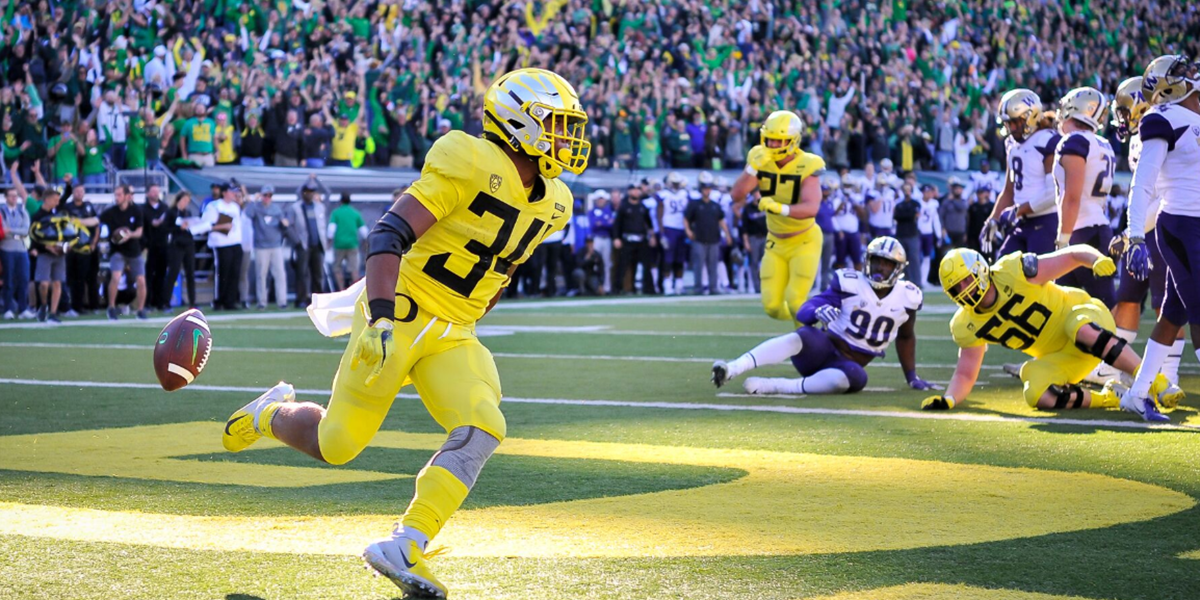For those longing for a return to the program’s peak offensive production of the past, the finality of spring football did not offer much for an Oregon Duck team that ranked 41st in total offense, 49th in passing offense and 54th in rushing offense in 2018. This is not entirely surprising however, as head coach Mario Cristobal emphasized that the spring game would not be a “dress rehearsal” for the real thing.
Nonetheless, the “Golden Era” of Oregon football (2009-14) showed how effective an offense can be by attacking the edges. In this analysis, we will examine the importance of attacking the edges and compare similar plays from both the Golden Era and the current Cristobal era. Some of these plays can be seen in offenses throughout the country over the past several years, giving optimism for Duck fans who long for the creativity offered from a bygone (albeit recent) period in program history.
Split Screen
The split screen plays above offer some nostalgia from the past, with identical reads and blocking schemes. The offensive formation places the defense in a situation where it will be outnumbered to one side.
This play has Oregon running a flare screen (red) and a tunnel screen (green). Each is designed to get blockers in front of a running back or receiver in space. The quarterback will read the one player that could impact either play. In this case the middle linebacker (white circle) has to make a choice, and the quarterback will simply throw away from him.
Wide Receiver Sweep and Sweep Read
The first two plays above (variations of wide receiver sweeps) can be either read plays or traditional run plays. Oregon has used the “read” version of the play over the past decade, and the versatility is proven. In the “Golden Era,” the Ducks split their blockers into separate assignments. In the first play above, the first four blockers to the left are assigned to block for a QB sweep (red), with Marcus Mariota running the ball.
The remaining five players to the right are blocking for a wide receiver jet sweep the other way (green). The deciding factor for which play to run, in this case, is the number of blockers in favor of the jet sweep. The receiver sweep has five blockers versus four defenders, while the QB sweep has four blockers against five defenders. This is an easy decision.
The remaining plays are similar, except the quarterback is running a power run play or faking an inside run play. Without a QB like Mariota who can stretch the defense laterally, Oregon is combining inside running plays to force the defense to pick its poison, so to speak. There are not enough defenders to commit sufficient manpower to both the edges and the interior.
Carving up Elite Defenses
The last time Oregon won an early season game against an elite team was the 2014 home contest against Michigan State. In that game we saw the Ducks win by attacking the edges with seam passes and outside runs once the inside run game became ineffective. The video above shows just a quick snapshot of how a game unfolds when forced to the edges. It will be interesting to see if there is a similar evolution come August 31st, when a veteran Oregon offensive line squares off against a talented Auburn Tigers defensive line.
Coach Jeremy Mosier
Geneseo, Illinois Top Photo by Kevin Cline
 Spencer Thomas, the FishDuck.com Volunteer Editor for this article, is an attorney for the Social Security Administration in Atlanta, Georgia, and coaches High School Football for Hillgrove HS in Powder Springs, GA.
Spencer Thomas, the FishDuck.com Volunteer Editor for this article, is an attorney for the Social Security Administration in Atlanta, Georgia, and coaches High School Football for Hillgrove HS in Powder Springs, GA.
Longtime Oregon Duck fan with family in Portland. Former Offensive coach at Glenwood High School in Illinois. Team qualified for the Sweet 16, 3 Elite 8 appearances, and one state championship game in class 6A. Currently an administrator at Geneseo High School in Illinois. Father to four kids ages 9, 7, 4, and 2 years old. Coached former athletes that have went on to play college football at numerous schools such as Clemson, Duke, and Army. NCAA athlete at Millikin University 2000-2004.

